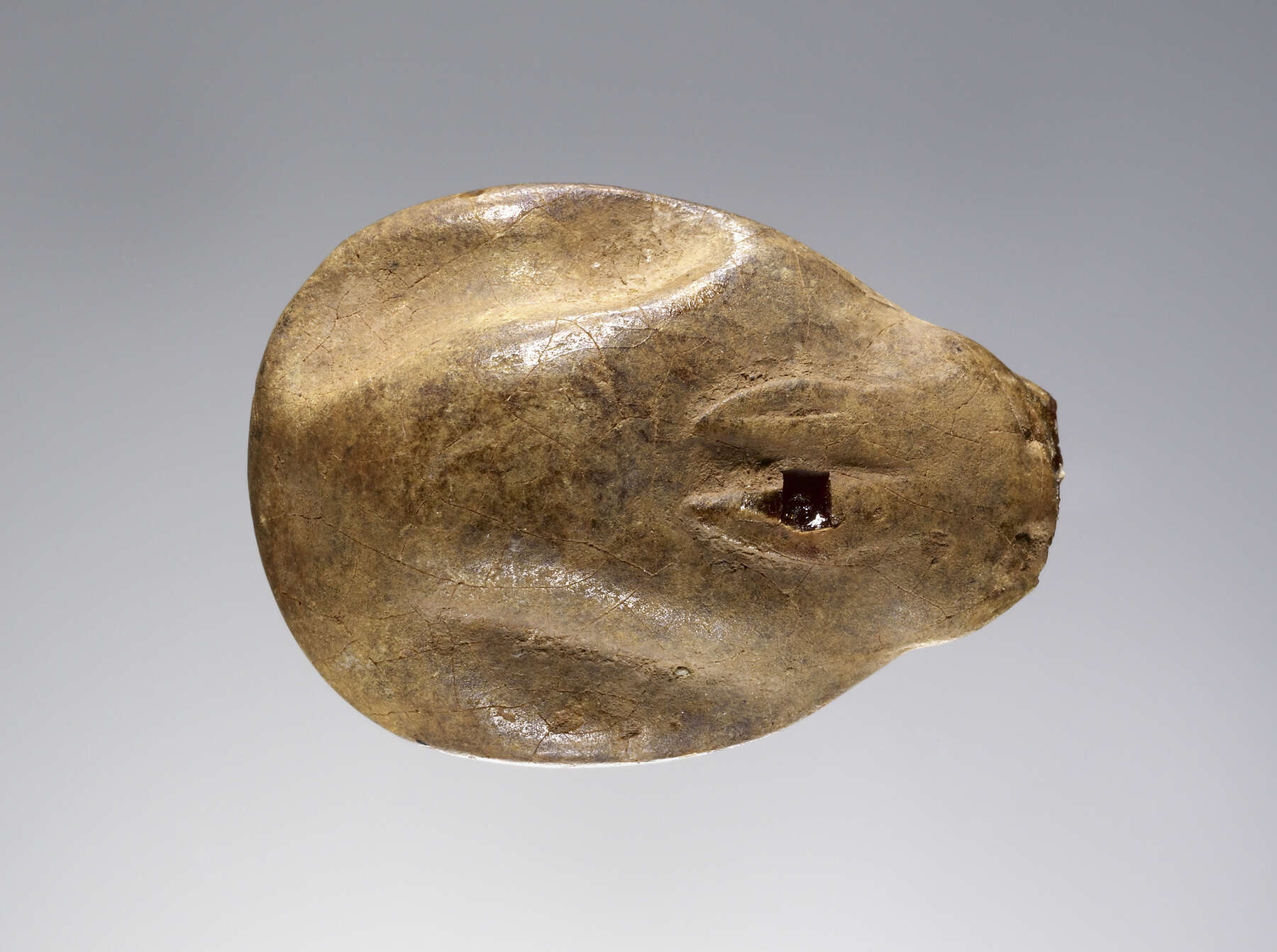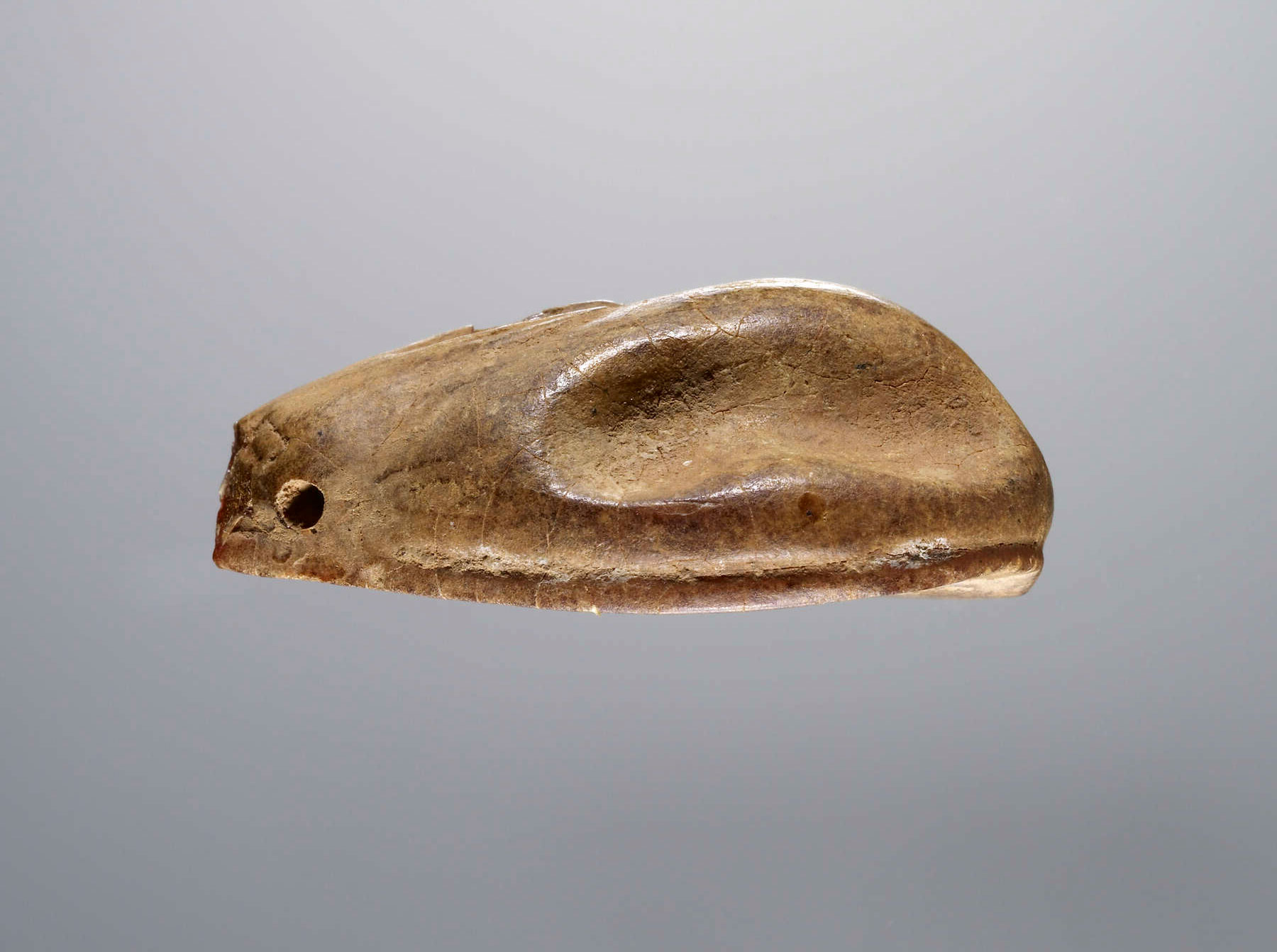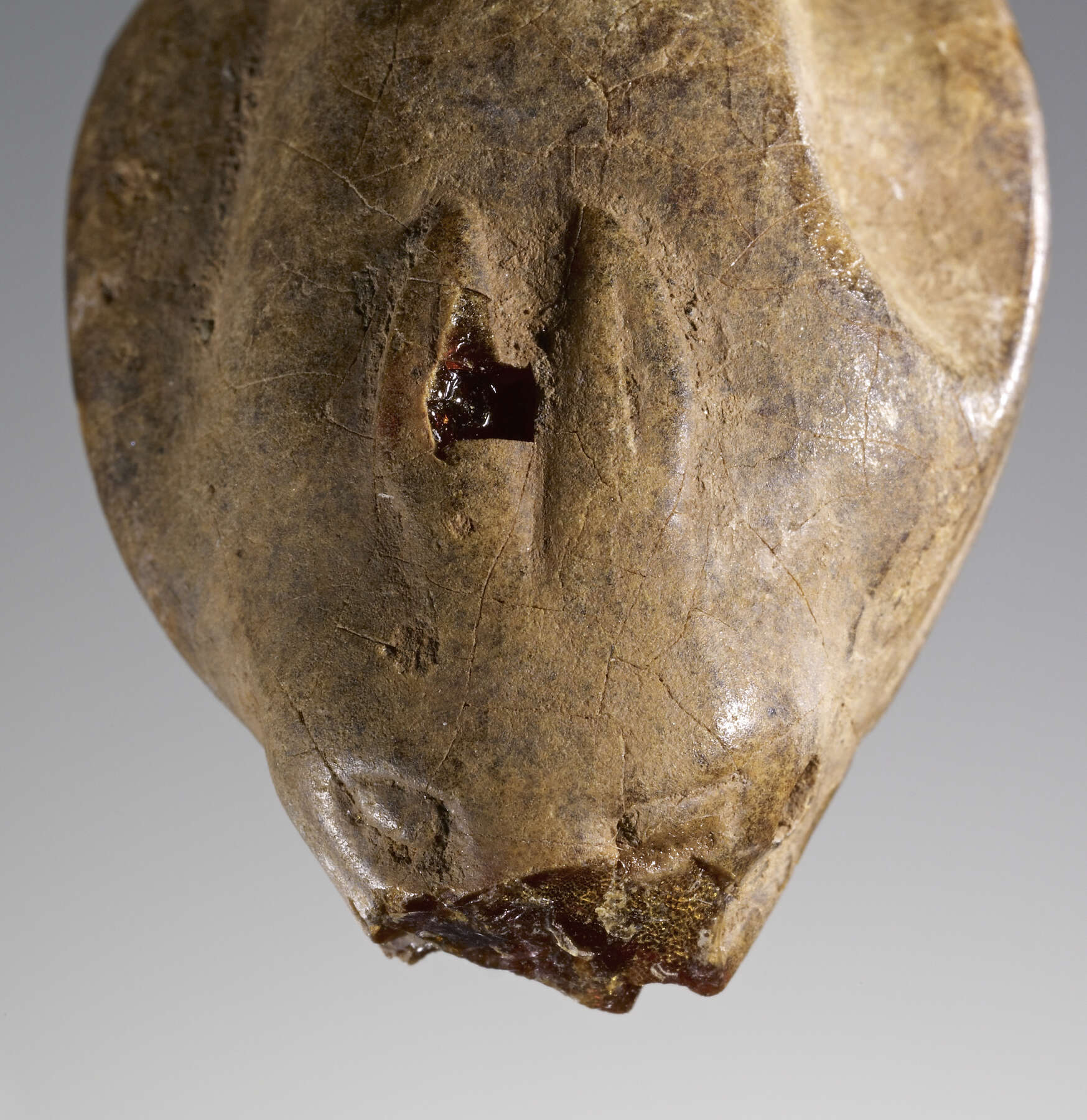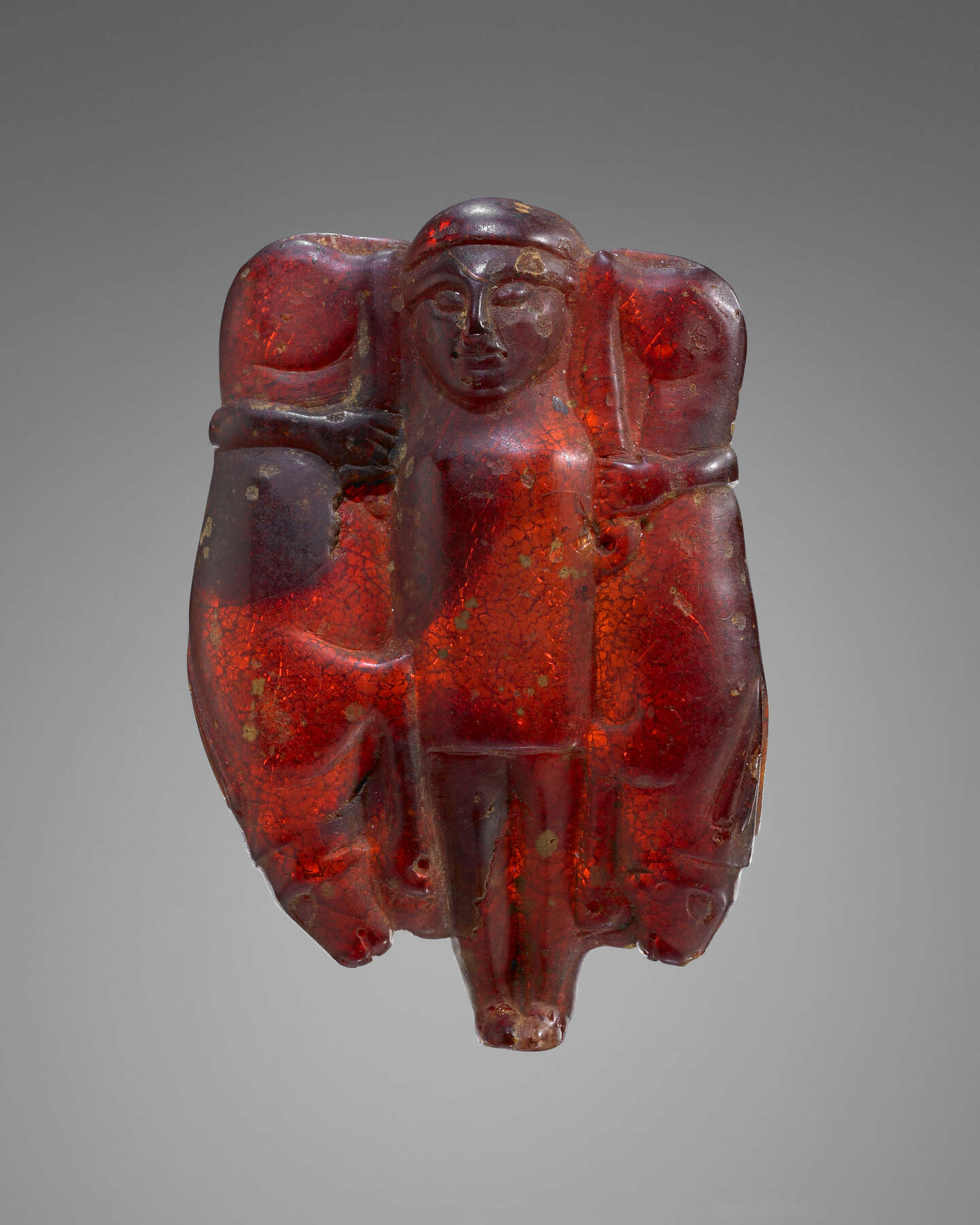30. Pendant: Cowrie Shell / Hare
| Accession Number | 79.AO.75.28 |
| Culture | Italic or Etruscan |
| Date | 600–500 B.C. |
| Dimensions | Height: 37 mm; width: 26 mm; depth: 14 mm; Weight: 3 g |
| Subjects | Color; Egypt; Fertility; Hare; Transparency |
Provenance
–1979, Stanley Silverman (Huntington Beach, CA), donated to the J. Paul Getty Museum, 1979.
Condition
The pendant is intact, with the exception of a large fracture loss to the nose and chips between the ears. The surface is smooth and firm. Minute surface crack patterns are visible on the dorsal surface and the ventral side. Before acquisition by the donor, the pendant was consolidated with a coating material that likely cemented together the consolidant, the yellow-ocher degraded amber, and soil, probably unintentionally. The amber is opaque and brownish yellow in ambient light, except at the break, where the rich red translucency of the interior is exposed. There are no visible inclusions.
Description
This teardrop-shaped pendant is an amalgamation of two sculptural forms, a crouching hare and a cowrie (Cypraeidae) modeled on the adult shell of the mollusk. The body of the hare is elevated from the ventral surface by a sort of platform. This is the edge of the cowrie shell. The rounded form of the pendant is a conflation of the hare’s back and the swelling of the cowrie’s dorsal surface. The hare is wide at the shoulders and narrow at the rump. Neither the front nor the hind legs are indicated. The hare’s ears are long, point straight backward, and lie flat on the animal’s head. Its almond-shaped eyes are carefully incised, tapering to a point at the outer canthi. The ventral surface is smoothed but not flat; it curves gently upward at the base of the cowrie’s anterior canal and at the edge. The aperture is represented as a long groove.
The pendant retains evidence of the prepared amber blank from which it was carved. The indentation on the left side of the hare’s body and the three declivities in the ventral surface (each approximately 6 mm wide by 7 mm in length) are likely the result of the prefiguration removal of imperfections. The amber’s natural form, perhaps originally a large drop, may have directed the figuration. Its shape may also have conditioned the position and shape of the hare’s eyes. The use of a graver is seen in the working of the eyes and the articulation of the long groove of the ventral surface and the groove separating the body from the base.
The pendant was suspended from a perforation that passes laterally through the cheeks of the hare; the exit holes are each 2 mm in diameter. When suspended, the animal would have faced upward, its back facing the viewer.
Discussion
This pendant is an extraordinary combination of four things: amber, a recumbent hare, a cowrie shell (the ventral side mimics the aperture), and, when hanging, the shape (in silhouette) of the Egyptian sign of the East, the flame of the new sun’s light. The lustrousness of the fossil resin echoes that of the shell, and its transparency the light of the sun. Like amber, the cowrie was highly valued for its rarity, distinctive colors, and luster; like the cowrie, amber had a marine aspect: amber was made, found, or transported by water, and some specimens may still have included encrustation of shells. Amber is like the color of the sun and flame.
“Cowrie” is the common name applied to marine gastropods belonging to Cypraeidae, a large family of marine snails abundant in the Indian Ocean, particularly in the East Indies and the Maldive Islands. (Cowries are also found off the coast of Southern California.) They characteristically have massive, smooth, shiny shells with striking patterns and colors. As is the case today, only some species of cowrie were highly prized (and imitated) in the ancient world; the most sought after then as now were those deemed “exotic,” that is, particularly rare, lustrous, or distinctly colored.1 Cowries were traded to Egypt as early as the fifth millennium B.C., and cowrie-shaped pendants used as ornaments are documented as early as the late Old Kingdom period in Egypt. The much-valued cowrie shell inspired various kinds of jewelry, direct transfers in hollow electrum, gold, and silver,2 as well as the cowroid, a mixture of the scarab and the cowrie, in which the scarab back was replaced with the cowrie shell and the underside engraved.3
Cowries are among the most popular of all pendant shapes in pre-Roman Italy and are among the first subjects to appear in amber, the earliest dating to the late eighth century B.C. Amber cowries gained popularity in the seventh century in Etruria, the mid-Adriatic, and the south of Italy and remained popular until the end of the fifth century B.C., when the shell was imitated in silver and in gold.4 Amber cowrie-shaped pendants come in all sizes, from 20 to 90 mm in length, and range in their degree of naturalism. Some pendants are schematic; others include greater morphological detail, as is the case with 79.AO.75.28. The evidence from controlled excavations of Orientalizing-period sites in South Italy shows that amber cowroids are documented exclusively in female graves, where they were the primary elements of necklaces and girdles. Other uses are documented, however. A unique pectoral with cowries and tiny female figures was buried with a woman in a grave at Ascoli Piceno.5 A late-seventh-to-early-sixth-century grave (Tomb 315) at Alianello-Cazzaiola documents another unusual use: the deceased woman was buried with an elaborate headband composed of small disk-shaped beads of ivory, bone, amber, and faïence, as well as with Egyptian faïence scarabs, real cowries, and a small amber imitation cowrie.6
The Getty cowrie-hare is one of six amber cowroid pendants known to me. A unique combination is the pendant from Tursi, dated to the first half of the eighth century B.C., which incorporates a cowrie and a scarab (but differently than in Egypt): one side of the Italic amber is a scarab and the other side that of a cowrie.7 The others are a cowrie-hare pendant in the Metropolitan Museum of Art,8 a schematically rendered cowrie / crouching hare, teardrop-shaped and with a plain underside, in a London private collection,9 and three hare-subject pendants in a German private collection.10 The Getty, New York, and London hare-cowrie pendants are all relatively close in size, although each is different in style and shows variations in form. The New York cowrie-hare is the most naturalistic: the raised base at the anterior canal of the cowrie, the distinctive caudal elongation of the hare’s head, and the rangy muscularity of the hare’s long body are faithfully captured.
This trio is related to the amber frog-cowrie pendants found at Vetulonia and to an example (now in the British Museum) said to come from Armento.11 A similar pendant was once in the Stroganoff collection,12 and another (allegedly from Metaponto) is recorded as once being on the art market.13 As with the scarab-cowrie combination, these hare-cowrie and frog-cowrie pendants bring together powerful subjects with age-old fertility, protection, and regenerative significance in amber, a material with the same properties.
The silhouette of this pendant, and of cowrie-shaped pendants in general, forms the shape of the Egyptian flame of sunlight, the sign of the East. The Egyptian flame accompanies the infant sun, the East, the direction of the sunrise and rebirth, an important step in the formation of the world.14
In Egypt, from the late Old Kingdom through the Late Period, both males and females wore hare and frog amulets, but the cowrie seems to have been worn exclusively by women.15 In Italy, the hare as a subject of adornment may have had resonance for both men and women; it might have symbolized a specific divinity: Dionysos, Artemis, or another female goddess of nature or the hunt. The hare and the frog were both associated with fertility, but a hare pendant might have had an additional significance in the tomb, offering its wearer special sight even in the dark, speed (away from danger and for fast passage through the afterworld), and the possibility of rebirth.16 The symbolic meaning of the hare in the iconographic tradition of Syria (the ultimate source of Phoenician hare images?) “grew out of its biotope (animal of the open fields and desert) on the one hand, and out of its stunning reproductive capacity (the superfecundatio was known since antiquity) on the other hand.”17 “Hare amulets may have stood for the vital forces connected with fertility …, alert quickness, and swiftness of the animal, and are to be viewed as life-giving symbols.”18 (See Divinity Holding Hares, , cat. no. 4, for additional discussion of the hare as a symbol.)
The mature cowrie has been likened in appearance to the human eye and female genitalia, both powerful danger-averting subjects.19 The cowrie shell has been used to “replace” the eyes of the deceased and in Egypt and Italy is especially important for women. The long and narrow aperture on the underside of the cowrie recalls the external appearance of the vulva, and with the animal emerging from it, birth itself. The overall shape of the shell may have been thought to intimate the shape of the womb, “so when beads of its shape formed an element of a woman’s girdle, they were in exactly the right place to ward off evil influences from the relevant bodily part of the wearer, especially if she were pregnant.”20
The function of a cowrie amulet would have been to enhance the particular bodily functions of the organs it represented (the eyes or the genitalia) and to act as a substitute for them in the afterworld. The amber, itself magic and regenerative, no doubt enhanced the fertility properties of the cowrie, as did the image of the proverbially fertile hare. That the hare and the cowrie are two animals in which the females are larger than the males must have added to the amuletic aspects of the pendant. In the tomb, the combination of hare and cowrie in a beautiful ornament-amulet might have been especially valuable for protection in rebirth or for the journey to the afterworld. In the beliefs of some in ancient Italy, this was a complicated voyage, part by land, part by sea, and part submarine.21
Notes
, p. 549, theorizing a source-distance gradient for Aurignacian-period personal ornaments, underlines that they were usually made of materials exotic to the regions in which they were found. This continues to hold true for the prehistoric period and the early historic period in Italy for amuletic and exotic materials, such as amber, ivory, and cowries. , pp. 62–66, discusses amber’s value, especially in light of its acquisition by political-religious elites living spatially distant from amber sources, and cites , p. 114: “Many exchanged items have inherent magical or religious significance as ‘power-charged’ treasures acquired from extraordinary realms outside their own heartland.” Indeed, as concludes on p. 130, “the ultimate goal of those seeking [shields or shell or stones or holy incense, or amber] may well be directed towards obtaining (maintaining) access to material manifestations of the power and potency that imbues their cosmos, thereby continuing their close association and inclusion with the dynamics of the universe of which they are an integral part.” This idea is more fully developed in M. W. Helms’s Access to Origins: Affines, Ancestors and Aristocrats (Austin, 1998).
The cowrie was associated with fertility and the sea, whose tides are controlled by the moon, the effect of which on women was well established. For this reason, among others, the moon is associated with many female fertility divinities in the Mediterranean, among them Artemis (with whom amber is also closely linked). An amber cowrie could be seen as a material manifestation of the dynamics of the universe.
↩- An early outstanding example is the girdle formed of gold cowries belonging to Queen Mereret (Dynasty 12) in the Cairo Museum: see, for example, , p. 42. ↩
- Ibid. Amber scarabs were among the first carved amber objects to appear in Italy in the Orientalizing period, with many excavated examples. Although many demonic subjects of Egyptian and Near Eastern origin appear to have lost or changed their meaning as the visual forms were adapted in Greece, Etruria, and elsewhere in Italy, the scarab seems never to have lost its original associations with the sun, life, and regeneration. The early amber scarabs and scaraboids are evidence of this. See A. F. Gorton, Egyptian and Egyptianizing Scarabs: A Typology of Steatite, Faience and Paste Scarabs from Punic and Other Mediterranean Sites (Oxford, 1996), p. 158, n. 65. ↩
- For example, the precious metal cowries buried with the woman in Tomb 419 at Banzi (along with three amber profile head-pendants): , p. 126. ↩
- I. Dall’Osso, Guida illustrata del Museo Nazionale di Ancona (Ancona, 1915), p. 303 (referred to by , p. 454, n. 1276). ↩
- For the headband from Tomb 315 at Alianello-Cazzaiola (Heraclea, Museo Nazionale della Siritide 209862), see I Greci in Occidente: Greci, Enotri e Lucani nella Basilicata meridionale (Naples, 1996), pp. 152–53, no. 2.12; and , p. 17, fig. 10. ↩
- , pp. 87–88 (discussed by S. Bianco). The amber was excavated from a woman’s tomb in the necropolis of Santa Maria di Anglona–Valle Sorigliano. ↩
- Metropolitan Museum of Art 1992.11.13, Purchase, Renée and Robert A. Belfer Philanthropic Fund, Patti Cadby Birch, and The Joseph Rosen Foundation Inc. Gifts, and Harris Brisbane Dick Fund, 1992: , pp. 295, 473, no. 343. ↩
- Unpublished. ↩
- These appear, from the photographs, to be similar to the London hare pendant: see K. A. Neugebauer, Antiken in deutschem Privatbesitz (Berlin, 1938), no. 255. ↩
- For the amber in the British Museum, see , p. 79, no. 72 (“Frog or toad”), pl. XXVIII. The effluent fertility of both frogs and toads (rarely differentiated in Egypt, according to Andrews) apparently led to their association with fertility generally and the renewal of life after death. The frog was seen as a chthonic animal that alluded to the forces which brought life into being. The Egyptian goddess Heket, who manifested herself in the shape of a frog or as a woman with a frog’s head, was also associated with childbirth. The goddess had “participated in the creation of the divine child, crouched beside the potter’s wheel on which Khnum shaped the small naked immortal, [and thus] all frog amulets might be intended to represent the goddess in her animal manifestation”: , p. 63. Representations of frogs are to be found on apotropaic wands, objects associated with the protection of new mothers and their babies: see E. Sullivan in The Quest for Immortality: Treasures of Ancient Egypt, ed. E. Hornung and B. M. Bryan (Washington, DC, 2002), p. 157, no. 71; and , p. 63. The frog amulet first appears in burials of predynastic date in Egypt, and similar amulets are known from Mesopotamia and Susa (for example, the lapis lazuli frog bead from a find at Early Dynastic IIIB Susa: , pp. 303–4, no. 202c). ↩
- , vol. 1, pl. XL, 3. ↩
- , p. 79, records that “a piece much nearer the style of this one was part of a find at Metapontum.” This find, which Strong refers to on p. 30, was on the London market in 1953; the photographs of the group were in the British Museum at the time of his writing, but are now lost. ↩
- A depiction of this initial stage in the formation of the world is found on a Ptolemaic granite sarcophagus, illustrated in , p. 24. ↩
- For the frog/toad, see , p. 63; for the cowrie, ibid., p. 42. Both of the latter subjects are known in third-millennium amulets from Sumer and ancient Susa. ↩
- For the hare in Egypt, see S. Schroer, “Hare,” in Iconography of Deities and Demons: Electronic Pre-publication (last revision November 15, 2006), www.religionswissenschaft.uzh.ch/idd/prepublication_3.php. ↩
- Schroer (see n. 16), p. 2, col. 1. ↩
- Ibid., col. 2. ↩
- , p. 107, notes that cowries have been used against the evil eye in many cultures. In addition to its rarity and lustrous beauty, other reasons why the cowrie accrued amuletic powers include the facts that the females of the Cypraeidae family are larger than the males; the shells secrete a purple staining liquid; and the life cycle of the cowrie includes a development metaphorically similar to that of female genitalia. Some cowries have coloration that looks like the skin of spotted cats, some have “eyes,” and some of the rarest cowrie species are thought to resemble female genitalia. Culled from R. J. Griffiths, “Size and Sex in Cypraeidae,” Proceedings of the Malacological Society of London 34, no. 6 (1961): 322; and F. Lorenz and A. Hubert, A Guide to Worldwide Cowrie, 2nd ed. (Hackenheim, 2000). ↩
- , p. 42. , p. 107, notes the similarity of Egyptian representations of cowrie-girdle wearers to the contemporary custom of women wearing cowries on girdles in some parts of the Sudan. See also G. Clark, Symbols of Excellence: Precious Materials as Expressions of Status (Cambridge, 1986), pp. 23–26, for further parallels in contemporary societies. ↩
- See, for example, . ↩
Bibliography
- Andrews 1994
- Andrews, C. Amulets of Ancient Egypt. Austin, TX, 1994.
- First Cities 2003
- Aruz, J., ed. Art of the First Cities: The Third Millennium B.C. from the Mediterranean to the Indus. With R. Wallenfels. Exh. cat. New York, 2003.
- Desroches-Noblecourt 2006
- Desroches-Noblecourt, C. Le secret des découvertes. Paris, 2006.
- Helms 1988
- Helms, M. W. Ulysses’ Sail: An Ethnographic Odyssey of Power, Knowledge, and Geographical Distance. Princeton, 1988.
- Jannot 2005
- Jannot, J.-R. Religion in Ancient Etruria. Translated by J. Whitehead. Madison, WI, 2005.
- Magie d’ambra 2005
- Magie d’ambra: Amuleti e gioielli della Basilicata antica. Exh. cat. Potenza, 2005.
- Ornamenti e lusso 2000
- Nava, M. L., and M. N. Santi, eds. Ornamenti e lusso: La donna nella Basilicata antica. Exh. cat. Rome, 2000.
- Art of the Classical World 2007
- Picón, C. A., et al. Art of the Classical World in the Metropolitan Museum of Art. New York, 2007.
- Pinch 1994
- Pinch, G. Magic in Ancient Egypt. Austin, TX, 1994.
- Pollak and Muñoz 1912
- Pollak, L., and A. Muñoz. Pièces de choix de la collection du comte Grégoire Stroganoff à Rome. 2 vols. Rome, 1912.
- Shennan 1993
- Shennan, S. “Amber and Its Value in the British Bronze Age.” In Amber in Archaeology: Proceedings of the Second International Conference on Amber in Archaeology, Liblice, 1990, edited by C. W. Beck and J. Bouzek, pp. 59–66. Prague, 1993.
- Strong 1966
- Strong, D. E. Catalogue of the Carved Amber in the Department of the Greek and Roman Antiquities. London, 1966.
- Waarsenburg 1995
- Waarsenburg, D. J. The Northwest Necropolis of Satricum: An Iron Age Cemetery in Latium Vetus. Amsterdam, 1995.
- White 1992
- White, R. “Beyond Art: Towards an Understanding of the Origins of Material Representations in Europe.” Annual Review of Anthropology 21 (1992): 537–64.





